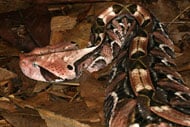Gaboon Viper
Most abundant in central and east Africa but of spotty distribution as far south as Zimbabwe and Zululand.
If not the most magnificent African venomous snake, it is certainly the most magnificent of the African viperine species. There are two subspecies, The East African, B. g. gabonica with small nasal horns and two dark triangles beneath each eye and the West African, B. g. rhinoceros with large nasal horns and a single triangle beneath each eye. Despite the immense size of this viper its ground and pattern colors of last autumnâs fallen leaves renders it nearly invisible on the forest floor. This is a slow moving snake that often crawls in a straight line (rectilinear movement). If startled or threatened it may coil but will as often merely freeze in place and depend on camouflage to avoid detection. This nocturnal snake is generally quiescent during the hours of daylight when it can seldom be induced to bite. It is more active and apt to bite at night. And you must keep in mind that a Gaboon can strike upwards or to the sides as well as forward.
Many of the gaboon vipers that are offered for sale are either wild collected or âfarmedâ in Africa. These should be checked for internal parasites. Sadly, many of these imports are also very badly dehydrated when received by hobbyists and it is imperative that they be induced to drinkâ”quickly and copiously. Even if the water dish is low and of broad diameter the Gaboon Viper may not recognize it for what it is. This lack of recognition can often be cured by roiling the waterâs surface with an aquarium air stone activated by a small vibrator pump. Eventually the gaboon will recognize even still waters for what they are.
A single gaboon viper can be housed in a 75 gallon capacity terrarium but larger is better; a pair should have a terrarium of at least 125 gallon capacity and again, larger is better. Although a substrate may be of folded newspaper, several thicknesses of paper towels, or aspen shavings, to truly appreciate the beauty and camouflage colors of this snake a bottom covering of cypress shavings and/or dried leaves is suggested. A hidebox may be used by a juvenile gaboon viper but adults usually merely sit quietly in the open. A receptacle of fresh, clean water must be present.
Daytime illumination should be provided. A temperature gradient should be provided these snakes. The cool end of the terrarium can be about 76 degrees Fahrenheit and the hot end about 85 degrees. A daytime hot spot of about 92 to 95 degrees should be provided by a basking lamp. Gaboon vipers are active all winter long. It does not require temperature manipulation to breed gaboon vipers. Often times breeding interests will be aroused by a passing frontal system that lowers barometric pressure. A gentle misting at this time may stimulate them further.
A litter may contain from 10 to more than 40, 9 to 14 inch long neonates.
Captive gaboon vipers thrive on suitably sized prekilled mice (baby snakes) or rats (adult snakes).
Small gaboons may be moved with a snakehook; large individual are so heavy that to move them safely you will need 2 snakehooks, one fore and one aft.

